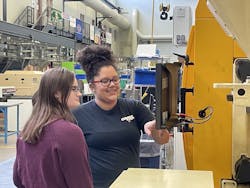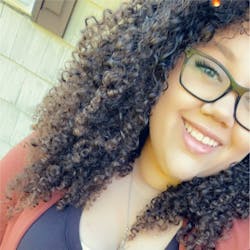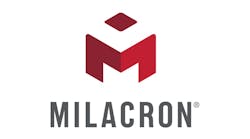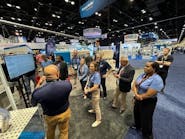By Karen Hanna
Growing up, Jovan Heusser didn’t see many people who looked like her pursuing professional STEM careers.
But those early experiences haven’t quashed her interest in science, technology, engineering and mathematics. At 23, the Butler, Pa., native is headed to rural upstate New York to work at custom molder Currier Plastics, as a young, biracial woman eager to embark on a career in an industry dominated by older white men.
She will be the company’s first Black woman engineer, said Diane Pisciotti, director of talent for Currier.
Heusser is not daunted by the challenge.
“I’ve always liked to do things on my own, and my mother instilled in me that just because I am a female doesn’t mean I can’t do something that a male can. It just gives me more reason to do it,” said Heusser, who is currently finishing up a Bachelor of Science degree in plastic engineering technology. “... I did have some issues in high school with bullying because of the color of my skin. That just gave me an incentive to kind of prove those naysayers wrong and become successful in something like that.”
At a time when many businesses are struggling to attract and retain workers, hiring experts have said that plastics companies must take off their blinders and examine how they can appeal to a more diverse pool of people to land the best workers.
The president of a service fraternity at Penn State Behrend, Heusser has shown over the course of two internships she definitely is a top-tier candidate, said Rob Knapp, manager for marketing and new business at Currier.
Currently, Heusser is working part time for the company remotely; she has been tasked with guiding the rollout of a new project management system.
Heusser truly commands a room when she is teaching other workers, Knapp said.
“We’re excited to bring her back on because we feel like she’s going to quickly move up the ranks.”
Representation matters
Kara Branch is the founder and CEO of Black Girls Do Engineer, a mentoring program based in Houston.
Like Heusser, she has pursued a path as an engineer.
In her work with middle-school and high-school-aged girls, she is trying to be the model neither she nor Heusser had — a Black woman forging a path in a man’s world.
“From my experience of being a Black woman in the work that I do, it’s because, a lot of times, Black women ... we never feel comfortable in these spaces,” Branch said.
A chemical engineer who has worked on NASA projects and earned a Master of Business Administration degree, Branch believes adults should help younger people realize that there is a place for them in those spaces.
“Representation is key for us. We believe you have to see it to believe it, and show them Black women who look like them who [are] in these industries and leaders in these industries doing this work,” Branch said.
While some companies are devoting more attention to issues around diversity, equity and inclusion, Branch said both employers and employees stand to gain from further efforts. In her experience, even issues like hairstyles, nail lengths and wardrobe can create feelings of alienation in workplaces.
“It’s not easy to get an engineering degree at all,” Branch said. “To be able to get an engineering degree, to be able to accomplish a lot of goals in your life and work hard to get somewhere, but you’re still having this constant fight throughout your entire career because you look different, right? This industry can be very challenging.”
Out of the comfort zone
When Heusser graduates this May, she will join an industry that has been slow to diversify. According to the U.S. Bureau of Labor Statistics (BLS), in 2021, women made up 31.9 percent of the plastic parts manufacturing industry; only 10.7 percent of the people in the industry were Black. Only about 7.3 percent of workers at those companies fell in Heusser’s age bracket — from 16 to 24 years old.
Among STEM degree holders, Black women account for an even smaller segment — just 2.9 percent of the overall pool, according to a report by Thomas, a marketing and advertising platform for the manufacturing industry. According to a 2021 Pew Research Center Report, “Black students earned 7 percent of STEM bachelor’s degrees as of 2018, the most recent year available, below their share of all bachelor’s degrees (10 percent) or their share of the adult population (12 percent).”
Overall, BLS statistics show that women make up 47 percent of the workforce, and Black people make up 12.3 percent of the workforce.
In Auburn, N.Y., where Currier is located, Heusser also will be part of a small minority; according to the 2020 U.S. Census, the town is home to fewer than 27,000 people — about 9.4 percent of them Black.
Pisciotti, who came to Currier after about 10 years at PricewaterhouseCoopers in New York City, acknowledged the talent pool in the Finger Lakes, N.Y., area, where the custom molder is located, is far less diverse than what she was used to in her first job. Still, in almost 11 years at Currier, she has seen the workforce grow from about 100 people to 200 — and the new employees are coming from broader backgrounds.
In mid-March, she reported the company had just hired a candidate who identifies as non-binary, as well as another woman manager. She believes there is value in finding people with experiences that aren’t already reflected in the workforce. That includes people who come from different economic backgrounds, as well as racial and gender minorities. Having already gained an admiration for Heusser’s professionalism, knowledge and talents, Pisciotti is excited to welcome her to a full-time role this summer.
“Jovan obviously has a very professional side to her … [and] she has a high level of technical skill and an educational background,” Pisciotti said.
Currier, Pisciotti said, continues to work on how it presents itself to candidates and employees, with the goal of ensuring all its workers are comfortable sharing their perspectives and opinions.
“We have become much more inclusive, and ... we’ve had to be, right? Even simple things like ... I would walk out to the lobby to greet a candidate, and they would be covered in tattoos, and you’d be like, ‘Ahh, maybe that’s not the look we’re going for,’ ” Pisciotti said.
But the company is coming around, trying to give everyone a fair shake.
“We have a couple of individuals who are transgender. From a very traditional conservative background as an ownership group, that was challenging to them at first,” she acknowledged.
“I can help to try to set that tone, but ultimately, it’s the people around them that are going to kind of make or break their experience with us,” Pisciotti said.
And, she said, employees across the company are getting the message: They’re all more successful together.
Working together
Finding common ground helps both companies and employees, Branch and Pisciotti said. But it takes effort.
“Within the diverse group, that’s what that does for your company: It really increases and enhances your performance in your company because you get so many different perspectives when you have a diverse group working for you,” Branch said.
Branch, who turns 33 at the end of April, said younger people are more apt to ask tough questions about companies’ workplace environments before they ever accept a job offer.
“They’re really particular about the jobs they go to. And it’s not even just about big companies. … I see a lot of them going to smaller startup companies, and get these top positions there,” she said.
In fact, she believes startups might be better positioned to create a diverse and welcoming workplace, because they have no traditions to challenge.
“Startups, I feel, have a better opportunity of diversifying their companies than these companies and corporations that have been established for 50-plus years, because you have the opportunity to bring in every background to really enhance that diversity effort upfront,” Branch said. “So, I feel like a lot of startups will be able to not have this problem as they continue to grow. But for corporations who have been more established, it’s most definitely going to be a long journey.”
Currier, which celebrates its 40th anniversary in September, is not shying from the challenge. The company is proud that employees routinely use words like “family” and “caring” to describe their workplace, Pisciotti said.
The company is a second-chance employer for people who have been released from jail or prison, and it has worked to promote an environment where all are welcome, she said.
One day in February, Pisciotti had just come from a round of interviews.
“I met with a candidate yesterday,” she said, “[who] said, ‘My goal is to live the American dream, and … [have] a Colonial house with a white picket fence,' and this young man was a Black American, and said, ‘My father grew up in manufacturing, and I think that there’s a way to make this work and to be successful,’ ” she said.
He got a job offer; so did the other minority candidate in the field of four who interviewed.
In June, Heusser, who is currently working for Currier online part-time, will join a diversifying workforce. She’s excited.
“I definitely like the challenge of engineering,” she said. “I’m more of a hands-on person. I do like the puzzles that engineering has, and I like to be mentally and academically pushed.”
She believes her coworkers at Currier will give her challenge, as well as support her.
“You are getting that push and you are being challenged by even your peers to come up with new things, of how things need to work,” she said.
Karen Hanna, senior staff reporter
More on the labor crunch
Read PMM's deep dive on the shortage of workers in the plastics industry: plasticsmachinerymanufacturing.com/21248002
Karen Hanna | Senior Staff Reporter
Senior Staff Reporter Karen Hanna covers injection molding, molds and tooling, processors, workforce and other topics, and writes features including In Other Words and Problem Solved for Plastics Machinery & Manufacturing, Plastics Recycling and The Journal of Blow Molding. She has more than 15 years of experience in daily and magazine journalism.







